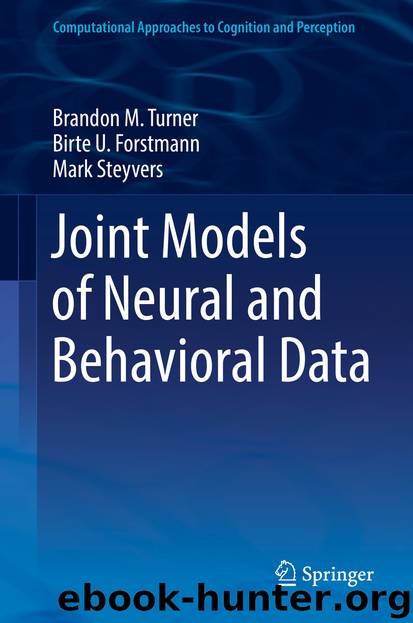Joint Models of Neural and Behavioral Data by Brandon M. Turner & Birte U. Forstmann & Mark Steyvers

Author:Brandon M. Turner & Birte U. Forstmann & Mark Steyvers
Language: eng
Format: epub
ISBN: 9783030036881
Publisher: Springer International Publishing
4.2.1 Generative Analysis
Once the model was fit to the data, Turner et al. [18] performed a number of analyses to interpret the pattern of activation in the brain through the lens of their cognitive model. Several of the analyses were based on an examination of the posterior predictive distribution (PPD) of the model parameters. The PPD serves as a generalization of the information obtained in the empirical data to new, hypothetical data that might have been observed had more trials been obtained in the experiment. The PPD provides a statistically coherent way to simultaneously form a quantification of uncertainty, and establish a “best” estimate for the predicted model parameters, based on the data that were observed. The PPD analysis is particularly advantageous when the data are sparse relative to the number of model parameters, as they were in this application. Because the analysis focused on the trial-to-trial brain-behavior covariation, Turner et al. generated the PPD from the hyperparameters of the multivariate normal distribution. The result was a set of starting point and drift rate parameters for new, hypothetical trials.
Once the PPD was generated, Turner et al. [18] defined regions within the PPD that corresponded to psychologically interpretable constructs, such as the rate of information processing and response efficiency. Defining the regions in this way allowed Turner et al. to glean psychologically meaningful constructs on the basis of the parameters in the model. Perhaps the most relevant analyses to the readers of this book are the drift rate analysis shown in Fig. 4.3. Within the DDM, the rate of stimulus information processing corresponds to the drift rate, and the degree of bias in the choice corresponds to the starting point. Figure 4.3a shows the PPD for drift rates (x-axis) and starting points (y-axis) generated from the model fits. Each colored region in Fig. 4.3a corresponds to a particular type of behavioral response pattern. For this analysis, Turner et al. defined one region corresponding to slow, error prone decision making (i.e., the red region of the PPD in Fig. 4.3a), and another region corresponding to fast, yet accurate decision making (i.e., the green region of the PPD in Fig. 4.3a).1 Using the parameters in these regions, one can also generate predictions from the model about the patterns of behavioral data to ensure that the chosen parameter regions are consistent with the definitions made about the type of decisions made. Figure 4.3b, c shows the predicted choice response time distributions for each correspondingly-colored region in the joint posterior distribution under accuracy and speed emphasis instruction, respectively.2 In each of the response time distribution plots, distributions corresponding to the correct decision are shown on the left (i.e., negative values), whereas distributions corresponding to the incorrect decision are shown on the right. In each panel, the model’s prediction for the probability of a correct response is represented as the density of the correct response time distribution relative to the incorrect response time distribution. These figures show that the high drift rate region produces responses that are both more accurate and faster than the low drift rate region.
Download
This site does not store any files on its server. We only index and link to content provided by other sites. Please contact the content providers to delete copyright contents if any and email us, we'll remove relevant links or contents immediately.
Rewire Your Anxious Brain by Catherine M. Pittman(18551)
Talking to Strangers by Malcolm Gladwell(13222)
The Art of Thinking Clearly by Rolf Dobelli(10214)
Mindhunter: Inside the FBI's Elite Serial Crime Unit by John E. Douglas & Mark Olshaker(9192)
Becoming Supernatural by Dr. Joe Dispenza(8119)
Change Your Questions, Change Your Life by Marilee Adams(7634)
Nudge - Improving Decisions about Health, Wealth, and Happiness by Thaler Sunstein(7615)
The Road Less Traveled by M. Scott Peck(7522)
The Lost Art of Listening by Michael P. Nichols(7403)
Enlightenment Now: The Case for Reason, Science, Humanism, and Progress by Steven Pinker(7228)
Mastermind: How to Think Like Sherlock Holmes by Maria Konnikova(7225)
Win Bigly by Scott Adams(7094)
The Way of Zen by Alan W. Watts(6505)
Daring Greatly by Brene Brown(6444)
Big Magic: Creative Living Beyond Fear by Elizabeth Gilbert(5610)
Grit by Angela Duckworth(5516)
Ego Is the Enemy by Ryan Holiday(5293)
Men In Love by Nancy Friday(5155)
Altered Sensations by David Pantalony(5043)
